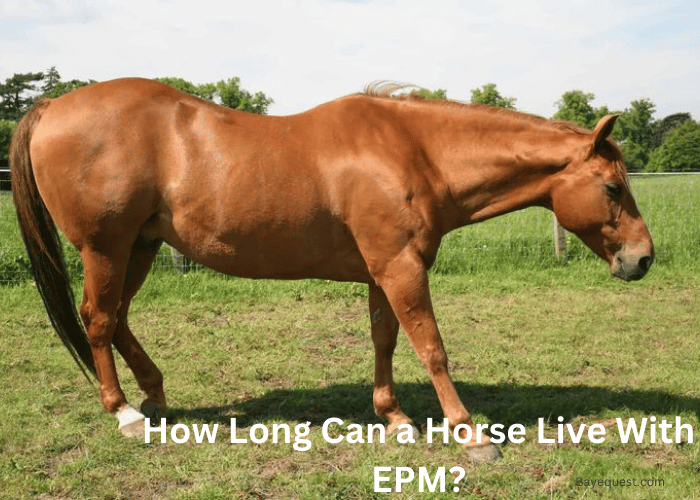EPM, or Equine Protozoal Myeloencephalitis, sounds like a mouthful, right? But if you own a horse, you need to know about it.
How long can a horse live with EPM? That’s the big question. The answer isn’t simple, but don’t worry—we’ll break it down.
From symptoms to treatment and everything in between, we’ve got the scoop. So, saddle up and let’s dive into the world of EPM and your horse’s future.
What is Equine Protozoal Myeloencephalitis (EPM)?
Equine Protozoal Myeloencephalitis (EPM) is a neurological disease in horses. It’s caused by a parasite called Sarcocystis neurona, which attacks the horse’s central nervous system.
Horses get infected by eating food or drinking water contaminated with the parasite. The disease affects the brain, brainstem, and spinal cord.
Symptoms can vary but often include muscle weakness, coordination issues, and abnormal gaits. Early diagnosis and treatment are crucial for the best outcome.
Causes of Equine Protozoal Myeloencephalitis
Equine Protozoal Myeloencephalitis (EPM) is caused by the parasite Sarcocystis neurona. This parasite primarily comes from opossums, which shed it in their feces.
Horses become infected by ingesting food or water contaminated with these feces. The parasite can also spread through intermediate hosts like raccoons, skunks, and armadillos.
These hosts carry the parasite and contribute to environmental contamination. Once ingested, the parasite invades the horse’s central nervous system, leading to the development of EPM.
Life Cycle of Sarcocystis neurona
The life cycle of Sarcocystis neurona begins with the opossum, which acts as the definitive host. The parasite’s sporocysts are shed in the opossum’s feces.
These sporocysts are the parasite’s infective stage and can contaminate the environment.
When intermediate hosts such as raccoons, skunks, and armadillos ingest the sporocysts, the parasite enters their bodies. Inside these hosts, the sporocysts develop into a different form, called bradyzoites, and form tissue cysts.
These intermediate hosts carry the parasite. When they die, the cysts can be released into the environment.
Horses become accidental hosts by ingesting food or water contaminated with sporocysts from opossum feces. Once inside the horse, the sporocysts release sporozoites, which migrate to the central nervous system.
There, they transform into merozoites, multiply, and cause neurological damage, leading to the symptoms of EPM. This completes the complex life cycle of Sarcocystis neurona.
How Long Can a Horse Live With EPM?
The lifespan of a horse with EPM varies based on several factors. Early detection is crucial; the sooner the disease is identified, the better the prognosis.
Effective treatment plays a significant role as well. Horses that receive prompt and appropriate treatment can often live many years, sometimes even a normal lifespan.
However, if EPM is severe or not treated adequately, the outlook can be less favorable. Some horses may experience lasting effects.
The quality of care and management they receive is also important. With proper care, many horses can live long and fulfilling lives despite having EPM.
Factors Affecting Longevity with EPM
Several factors affect a horse’s longevity with EPM. These include:
Early detection. The sooner EPM is diagnosed, the better the chances of effective treatment and recovery.
Severity of infection. Mild cases are easier to manage and treat compared to severe infections that have caused significant neurological damage.
Effectiveness of treatment. Prompt and appropriate treatment, including medications and supportive therapies, can greatly improve outcomes.
Overall health. A horse’s general health and immune system strength play a crucial role in recovery. Healthy horses are better equipped to fight off the infection and recover.
Quality of care. Ongoing veterinary care, proper nutrition, and a stress-free environment can enhance a horse’s ability to manage EPM.
Timeliness of intervention. Quick intervention can prevent the progression of the disease, reducing the likelihood of long-term damage.
Supportive management. Physical therapy and modifications to the horse’s environment can help maintain their quality of life and functionality.
Risk Factors of Equine Protozoal Myeloencephalitis
Certain factors can increase a horse’s likelihood of developing EPM. These include:
Environmental exposure. Horses that graze in pastures frequented by opossums or other intermediate hosts (like raccoons and skunks) are at higher risk. Contaminated feed and water sources are common routes of infection.
Geographic location. EPM is more prevalent in areas where opossums are common, such as North and South America.
Age. Younger horses and older horses are more susceptible due to their weaker immune systems.
Stress. Stress from transportation or heavy training can weaken a horse’s immune system, making them more susceptible to infection.
Immune system health. Horses with compromised or weakened immune systems are at a higher risk of developing EPM.
Travel. Horses that are frequently transported or come into contact with other horses from different areas are at an increased risk of exposure to the parasite.
Management practices. Poor stable management can increase the risk of EPM by creating environments conducive to the presence of intermediate hosts.
Prevalence of EPM
The prevalence of EPM varies geographically, primarily because it depends on the presence of the definitive host.
In North and South America, where opossums are common, the risk of EPM is higher. Approximately 50-60% of horses in these regions have been exposed to the parasite, Sarcocystis neurona.
However, not all exposed horses develop the disease. The actual clinical prevalence is lower, estimated at 1-2%.
Factors such as environmental contamination, horse management practices, and the presence of intermediate hosts contribute to this variability.
Signs and Symptoms of Equine Protozoal Myeloencephalitis
Signs and symptoms of EPM can vary widely, but they often include the following:
1. Ataxia. Loss of coordination causes the horse to stagger or have an unsteady gait.
2. Muscle atrophy. Noticeable muscle wasting, particularly in the hindquarters.
3. Weakness. Generalized or localized weakness, often asymmetrical, affects one side more than the other.
4. Abnormal gait. Lameness or irregular walking patterns.
5. Head tilt. Tilting of the head to one side due to neurological damage.
6. Seizures. In severe cases, the horse may experience seizures.
7. Difficulty swallowing. Problems with eating and drinking, leading to weight loss and dehydration.
8. Facial nerve paralysis. Drooping of the eyelids, ears, or lips on one side of the face.
9. Behavioral changes. Altered behavior, such as depression, lethargy, or irritability.
How to Diagnose Equine Protozoal Myeloencephalitis
Diagnosing Equine Protozoal Myeloencephalitis (EPM) involves several steps:
Clinical examination. A thorough physical and neurological examination by a veterinarian to identify symptoms consistent with EPM.
Medical history. Reviewing the horse’s medical history and environmental exposure to risk factors, such as contact with opossums.
Blood tests. Testing for antibodies against Sarcocystis neurona. A positive result indicates exposure but not necessarily active infection.
Cerebrospinal Fluid (CSF) analysis. Collecting and analyzing CSF to detect antibodies or DNA of Sarcocystis neurona. This is a more definitive test for active infection.
Exclusion of other diseases. Ruling out other neurological conditions with similar symptoms, such as West Nile virus, equine herpesvirus, and wobbler syndrome.
Imaging. Occasionally, advanced imaging techniques like MRI or CT scans may be used to assess the extent of neurological damage.
Treatment and Management of Equine Protozoal Myeloencephalitis
Treating and managing EPM involves a comprehensive approach. Let’s dive into the key strategies for treating and managing EPM in horses.
1. Medications
Antiprotozoal drugs. Ponazuril, diclazuril, and sulfadiazine/pyrimethamine are commonly used to kill the parasite.
Anti-inflammatory drugs. Non-steroidal anti-inflammatory drugs can help reduce inflammation and manage pain.
2. Supportive care
Physical therapy. Customized exercises to improve muscle strength, coordination, and balance.
Nutritional support. Ensuring the horse receives a balanced diet to support overall health and recovery.
Stress reduction. Minimizing stress through environmental enrichment and stable management practices.
3. Monitoring and follow-up
Regular veterinary check-ups. Frequent evaluations to monitor progress and adjust treatment plans as necessary.
Neurological assessments. Periodic assessments to track improvements or any new symptoms.
4. Environmental management
Sanitation. Keeping feed and water sources clean and protected from contamination by opossum feces.
Pest control. Implementing measures to reduce the presence of opossums and other intermediate hosts around the stable and pastures.
5. Long-term management.
Maintenance therapy. In some cases, long-term or intermittent use of low-dose antiprotozoal drugs may be necessary.
Lifestyle adjustments. Adjusting the horse’s workload and activity level based on neurological status and physical capabilities.
Read also: How to Treat Arthritis in Horses.
Prognosis of EPM
The prognosis of EPM varies. Many horses recover and lead normal lives if caught early and treated well. Some might have lingering issues but can still be active and happy.
In severe cases, the damage might be too much, affecting the horse’s quality of life. Regular check-ups and good care make a big difference.
Many horses with EPM can do well with the right treatment and management.
How to Prevent Equine Protozoal Myeloencephalitis
Preventing EPM is all about reducing exposure to the parasite.
Start by keeping feed and water clean and protected from opossums. Control pests around your barn and pastures.
Regularly clean up spilled grain and keep feed bins covered. Limit your horse’s contact with wildlife. Ensure good, stable management and hygiene practices.
Regular vet check-ups can catch early signs before they become a problem. By staying proactive, you can help keep your horse safe from EPM.
FAQS
Can a horse fully recover from EPM?
Yes, many horses can fully recover from EPM if it’s caught early and treated promptly. However, some may have lingering effects, depending on the severity of the infection.
What happens if EPM is left untreated?
If left untreated, EPM can cause severe neurological damage. This can lead to worsening symptoms, significant loss of coordination, muscle wasting, and potentially permanent disability.
Are horses with EPM in pain?
Horses with EPM may experience discomfort due to muscle weakness and coordination issues. While pain is not always a primary symptom, the disease can cause significant stress and physical challenges.
Is it okay to ride a horse with EPM?
It depends on the horse’s condition. If the horse is showing mild symptoms and is under veterinary care, light riding may be possible. However, severe cases require rest and rehabilitation. Always consult your vet before riding a horse with EPM.
Conclusion
In conclusion, while EPM is a serious disease, many horses can live long and happy lives with the right care. Early detection, effective treatment, and good management are key.
Don’t let EPM steal your horse’s thunder. Stay vigilant, work with your vet, and keep those hooves dancing.
With a proactive approach, your horse can continue to enjoy many great years ahead.








